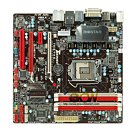- Joined
- Oct 9, 2007
- Messages
- 47,853 (7.39/day)
- Location
- Dublin, Ireland
| System Name | RBMK-1000 |
|---|---|
| Processor | AMD Ryzen 7 5700G |
| Motherboard | Gigabyte B550 AORUS Elite V2 |
| Cooling | DeepCool Gammax L240 V2 |
| Memory | 2x 16GB DDR4-3200 |
| Video Card(s) | Galax RTX 4070 Ti EX |
| Storage | Samsung 990 1TB |
| Display(s) | BenQ 1440p 60 Hz 27-inch |
| Case | Corsair Carbide 100R |
| Audio Device(s) | ASUS SupremeFX S1220A |
| Power Supply | Cooler Master MWE Gold 650W |
| Mouse | ASUS ROG Strix Impact |
| Keyboard | Gamdias Hermes E2 |
| Software | Windows 11 Pro |
Biostar is ready with its pair of mid-range motherboards for the upcoming LGA1155 Sandy Bridge processor platform, based on the Intel P67/H67 Express chipsets. The two were earlier pictured in their pre-release forms at this year's Computex event. Both models fall into the company's mid-range TSeries family. The TSeries TP67XE is the larger (ATX) model that builds slightly over the chipset's feature set, it is outfitted with USB 3.0 and SATA 6 Gb/s (2 ports each). The rather high-end looking CPU VRM uses a total of 9 phases, power is drawn from two 8-pin ATX EPS connectors (probably connecting both connectors is optional, and only to enhance overclocking). Expansion slots include two each of PCI-Express 2.0 x16 (electrical x8/x8, when both are populated), PCI-Express x1, and PCI. Connectivity includes 8-channel HD audio, gigabit Ethernet, USB 3.0, FireWire, eSATA 3 Gb/s, and a number of USB 2.0 ports.
The second smaller (micro-ATX) board, the TSeries TH67XE, is based on the H67 chipset, and supports FDI that lets you use the integrated graphics processor on some processors. It uses a simpler 6+1 phase VRM, and goes slightly easy on the overclocking-capability department, but does retain USB 3.0 and SATA 6 Gb/s. Expansion slots include one PCI-Express 2.0 x16, one PCI-Express x16 (electrical x4), a PCI-Express x1, and a PCI. One out of six of the SATA 3 Gb/s channels from the PCH are assigned as an eSATA port. Other connectivity features include 8-channel HD audio, FireWire, gigabit Ethernet. Display connectivity includes DVI and D-Sub. Both boards will be out by the year's end, when Intel releases its new processor platform.


View at TechPowerUp Main Site
The second smaller (micro-ATX) board, the TSeries TH67XE, is based on the H67 chipset, and supports FDI that lets you use the integrated graphics processor on some processors. It uses a simpler 6+1 phase VRM, and goes slightly easy on the overclocking-capability department, but does retain USB 3.0 and SATA 6 Gb/s. Expansion slots include one PCI-Express 2.0 x16, one PCI-Express x16 (electrical x4), a PCI-Express x1, and a PCI. One out of six of the SATA 3 Gb/s channels from the PCH are assigned as an eSATA port. Other connectivity features include 8-channel HD audio, FireWire, gigabit Ethernet. Display connectivity includes DVI and D-Sub. Both boards will be out by the year's end, when Intel releases its new processor platform.


View at TechPowerUp Main Site








